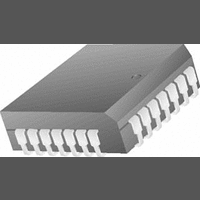CS5102A-BL Cirrus Logic Inc, CS5102A-BL Datasheet - Page 28

CS5102A-BL
Manufacturer Part Number
CS5102A-BL
Description
A/D Converter (A-D) IC
Manufacturer
Cirrus Logic Inc
Specifications of CS5102A-BL
Input Channels Per Adc
2
Mounting Type
Surface Mount
No. Of Channels
2
Power Rating
44mW
Supply Voltage Min
4.5V
Peak Reflow Compatible (260 C)
No
Sample Rate
20kSPS
Supply Voltage Max
5.5V
Lead Free Status / RoHS Status
Contains lead / RoHS non-compliant
Available stocks
Company
Part Number
Manufacturer
Quantity
Price
Part Number:
CS5102A-BL
Manufacturer:
CRYSTAL
Quantity:
20 000
Company:
Part Number:
CS5102A-BLZ
Manufacturer:
Cirrus Logic Inc
Quantity:
10 000
Part Number:
CS5102A-BLZ
Manufacturer:
CRYSTAL
Quantity:
20 000
8192
6144
4096
2048
shows a histogram plot of output code occur-
rences obtained from 8192 samples taken from a
CS5101A in the bipolar mode. Hexadecimal code
7FFE was arbitrarily selected and the analog in-
put was set close to code center. With a noiseless
converter, code 7FFE would always appear. The
histogram plot of the device has a "bell" shape
with all codes other than 7FFE due to internal
noise. Figure 22 illustrates the noise histogram of
the CS5102A.
In a sampled data system all information about
the analog input applied to the sample/hold ap-
pears in the baseband from dc to one-half the
sampling rate. This includes high-frequency com-
ponents which alias into the baseband. Low-pass
(anti-alias) filters are therefore used to remove
frequency components in the input signal which
are above one-half the sample rate. However, all
wideband noise introduced by the CS5101A and
CS5102A still aliases into the baseband. This
"white" noise is evenly spread from dc to one-
half the sampling rate and integrates to 35 V rms
in unipolar mode.
Noise in the digital domain can be reduced by
sampling at higher than the desired word rate and
28
Counts:
Figure 21. 5101A Histogram Plot of 8192 Conversion
Count
7FFB
0
7FFC 7FFD
0
989
Code (Hexadecimal)
Inputs
7FFE
6359
7FFF
844
8000
0
Noiseless
Converter
CS5101A
8001
0
8192
6144
4096
2048
averaging multiple samples for each word. Over-
sampling spreads the device’s noise over a wider
band (for lower noise density), and averaging ap-
plies a low-pass response which filters noise
above the desired signal bandwidth. In general,
the device’s noise performance can be maximized
in any application by always sampling at the
maximum specified rate of 100 kHz (CS5101A)
or 20 kHz (CS5102A) (for lowest noise density)
and digitally filtering to the desired signal band-
width.
Aperture Jitter
Track-and-hold amplifiers commonly exhibit two
types of aperture jitter. The first, more appropri-
ately termed "aperture window", is an input
voltage dependent variation in the aperture delay.
Its signal-dependency causes distortion at high
frequencies. The proprietary architecture of the
CS5101A and CS5102A avoids applying the in-
put voltage across a sampling switch, thus
avoiding any "aperture window" effects. The sec-
ond type of aperture jitter, due to component
noise, assumes a random nature. With only
100 ps peak-to-peak aperture jitter, the CS5101A
and CS5102A can process full-scale signals up to
Counts:
Figure 22. 5102A Histogram Plot of 8192 Conversion
Count
7FFD
0
7FFE
5
7FFF 8000(H)
1727
Code (Hexadecimal)
CS5101A CS5102A
Inputs
4988
8001
1467
8002
5
Noiseless
Converter
CS5102A
8003
DS45F2
0


















